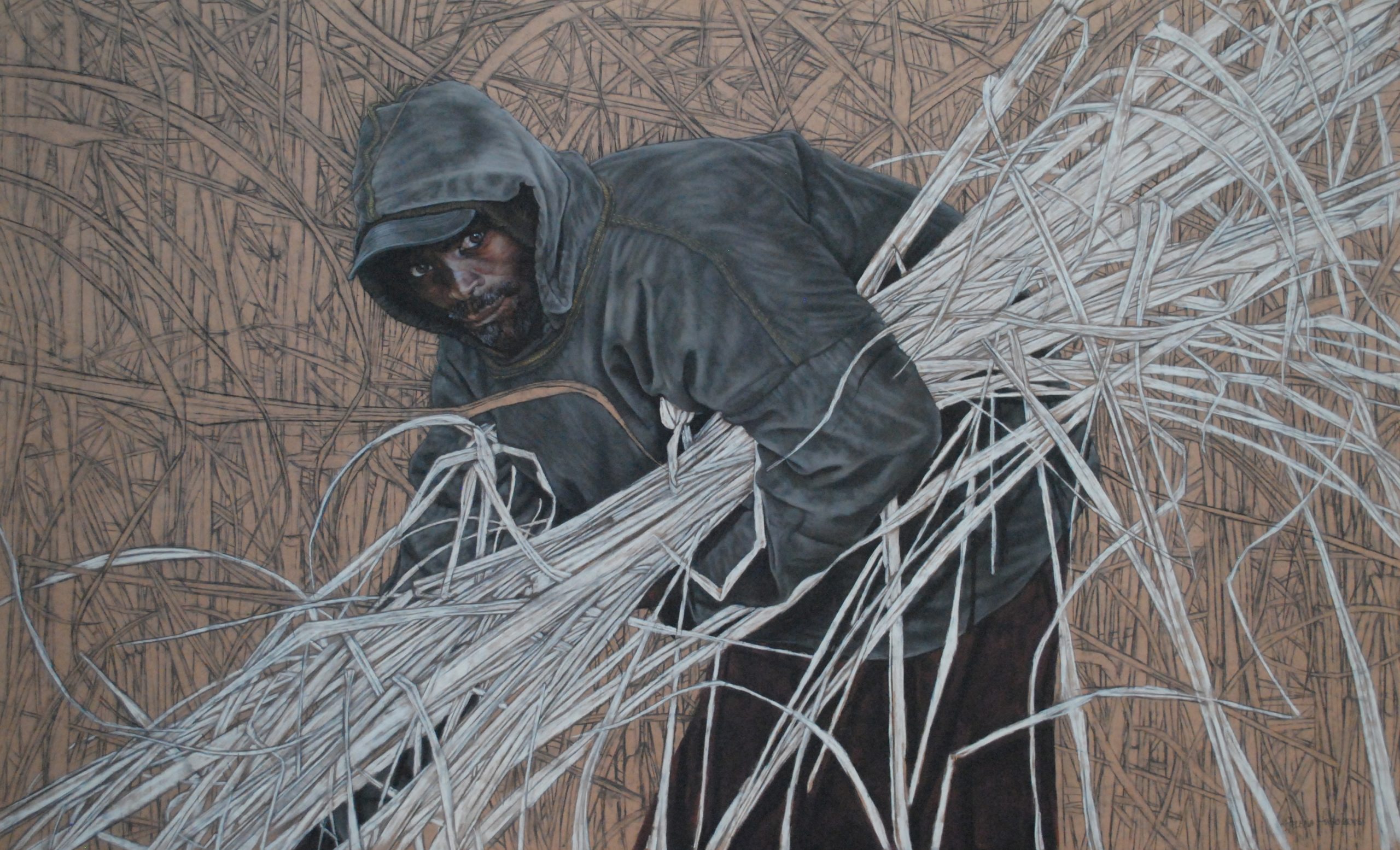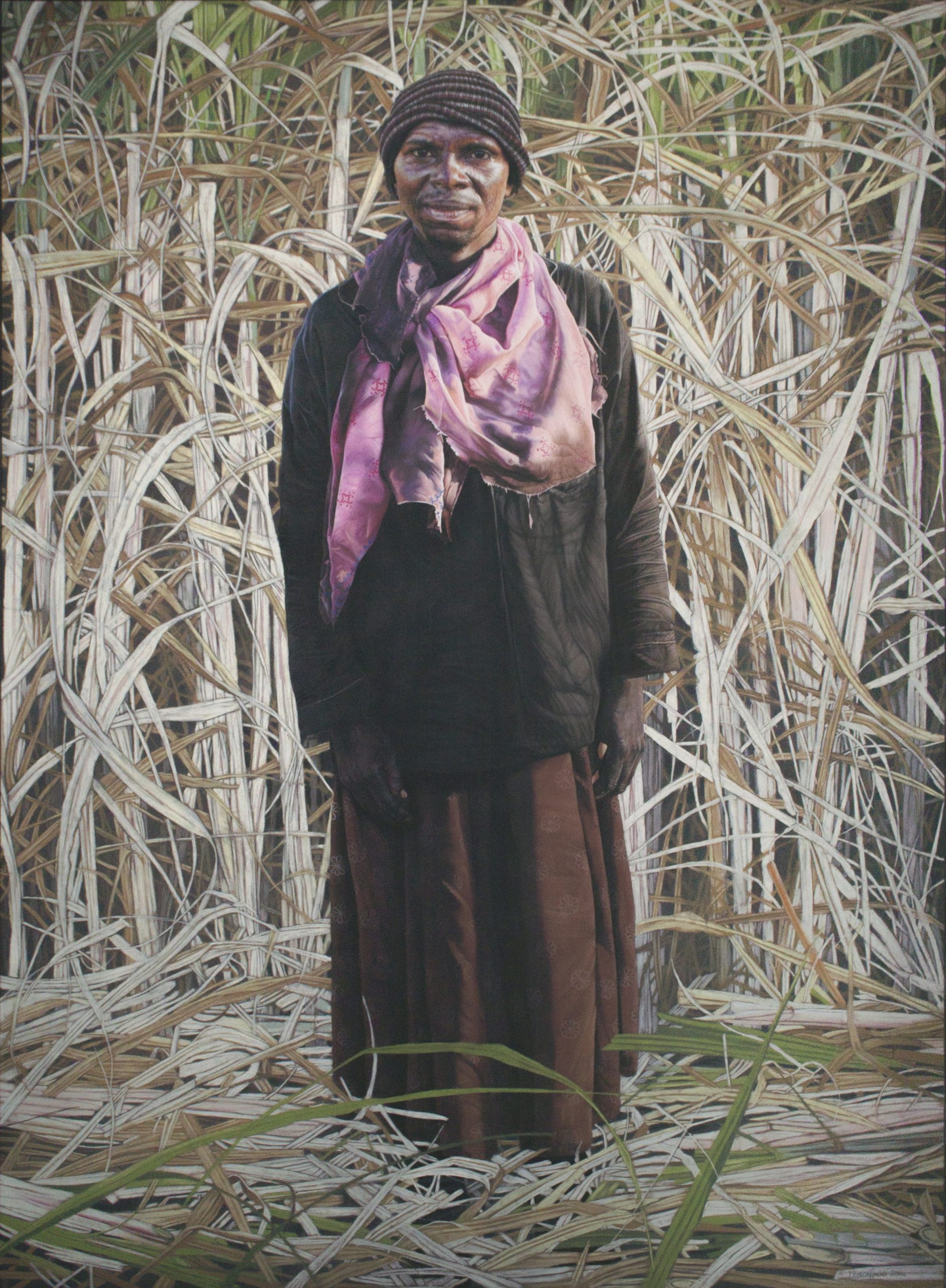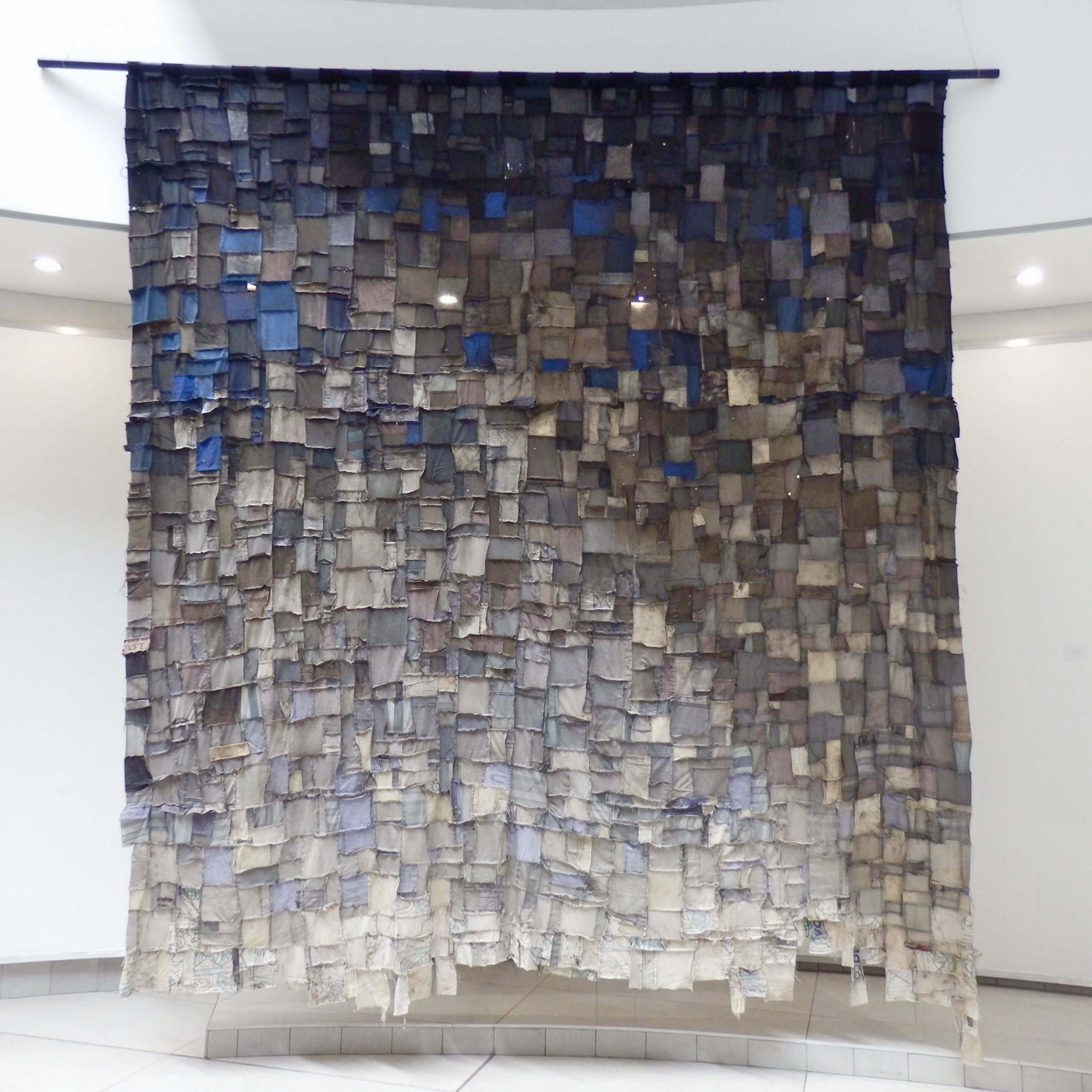Grass People 2015 - 2016
Human fragility and the cycle of life, death and resurrection are
the main themes embodied in Grass People. The exhibition consists of a series of detailed portraits of sugar
cane workers as well as fibre art pieces made from the clothes worn
by the portrayed individuals.
Using as a point of departure, sugar cane cutters and sugar cane, Hugo explores the human condition and the fate of us all.
Sugar cane - a type of grass - becomes a metaphor for our lives and the impermanence thereof and also represents the cycle of birth, death and resurrection. Like the grass of the field or a wild flower our earthly time is short and our lives are vulnerable and unpredictable - withering away.
The sugar cane plant has its own significant life cycle. Each year it is burned, cut down to the ground and thereafter even poisoned to make it “suffer” in order to increase its sugar content. Yet, it rises again in spring - like a phoenix from the ashes, growing up to two meters in 12 weeks.
And what become of the burnt reeds? The life essence of the plant
is finally crystallized from these as pure white sugar by the removal
of impurities after a long process of crushing, diffusing and boiling
- an appropriate metaphor for resurrection and hope after adversity
and tribulation.
The sugar cane cutters with their heads covered or hooded, their pangas scythe-like and depicted among the fallen sugar cane reeds remind us of grim reapers. Determined, they are still only there to do their job.
Their clothes, old garments that wear away like lives, are not clothes any more, but taken apart and re-appropriated - another reminder of impermanence. Yet, clothes also become a symbol of new life and resurrection, re-established here as reborn objects with new meaning.
Clothes form a strong personal bond with the owner's life because of its closeness to the wearer's body, saturated with sweat and in this case sugar cane juice and soot and always worn within the wearer's milieu, becoming one with body movement, living and working.
African textiles are significant in that they have always played an important role in tribal identity, status, life celebrations and burial rituals as well as being a sign of mind states like bereavement in the case of a funeral or joy at a wedding.
The weaving process itself represents spiritual and mythical
values. During each stage of spinning and weaving, there is a
symbolic parallel to human reproduction and resurrection.
The thread that weaves through this exhibition is analogous to the universal connection between us all by means of our human condition. This condition may not be an abruptly ending linearity, but is more likely to be circular and never ending. In a poem from his publication Leaves of Grass, Walt Whitman, after observations of graveyard grass, aptly describes our ending as he sees it: “All goes onward and outward, nothing collapses and to die is different from what any one supposed, and luckier.”
4 - 28 November 2015, Alliance Française, Johannesburg
12
December 2015 - March 2016, Absa Gallery, Johannesburg
 Reaper I
208cm x 122cm
Pastel and charcoal on board
Reaper I
208cm x 122cm
Pastel and charcoal on board Reaper I (detail)
Reaper I (detail) Reaper II
208cm x 122cm
Pastel and charcoal on board
Reaper II
208cm x 122cm
Pastel and charcoal on board Reaper II (detail)
Reaper II (detail) Reaper III
208cm x 122cm
Pastel and charcoal on board
Reaper III
208cm x 122cm
Pastel and charcoal on board Reaper III (detail)
Reaper III (detail) Reaper IV
208cm x 122cm
Pastel and charcoal on board
Reaper IV
208cm x 122cm
Pastel and charcoal on board They Wither Thereof I
50cm x 25cm
Pastel on board
They Wither Thereof I
50cm x 25cm
Pastel on board
 They Wither Thereof II
50cm x 25cm
Pastel on board
They Wither Thereof II
50cm x 25cm
Pastel on board
 Reaping the Harvest I
122cm x122cm
Pastel on board
Reaping the Harvest I
122cm x122cm
Pastel on board Reaping the Harvest II
122cm x 80cm
Pastel and charcoal on board
Reaping the Harvest II
122cm x 80cm
Pastel and charcoal on board In the Sugar Fields III
167cm x 122cm
Pastel on board
In the Sugar Fields III
167cm x 122cm
Pastel on board Man is like Grass I
80cm x 122cm
Charcoal and ink on board
Man is like Grass I
80cm x 122cm
Charcoal and ink on board Man is like Grass II
80cm x 122cm
Charcoal and ink on board
Man is like Grass II
80cm x 122cm
Charcoal and ink on board L1204C
60cm x 44cm
Pastel on board
L1204C
60cm x 44cm
Pastel on board Sugar and Soot
360cm x 350cm
Sugar cane cutter clothing and cotton thread
Sugar and Soot
360cm x 350cm
Sugar cane cutter clothing and cotton thread All Death is Natural but Your Death is Unexpected
250cm diameter
Sugar cane cutter clothing, cotton thread and wire
All Death is Natural but Your Death is Unexpected
250cm diameter
Sugar cane cutter clothing, cotton thread and wire Shiny Artifact of the Past - Man
60cm x 20cm x 20cm
Sugar cane cutter clothing, plastic, bandage, wire and cotton thread
Shiny Artifact of the Past - Man
60cm x 20cm x 20cm
Sugar cane cutter clothing, plastic, bandage, wire and cotton thread
 Shiny Artifact of the Past - Woman
60cm x 20cm x 20cm
Sugar cane cutter clothing, plastic, bandage, wire and cotton thread
Shiny Artifact of the Past - Woman
60cm x 20cm x 20cm
Sugar cane cutter clothing, plastic, bandage, wire and cotton thread


